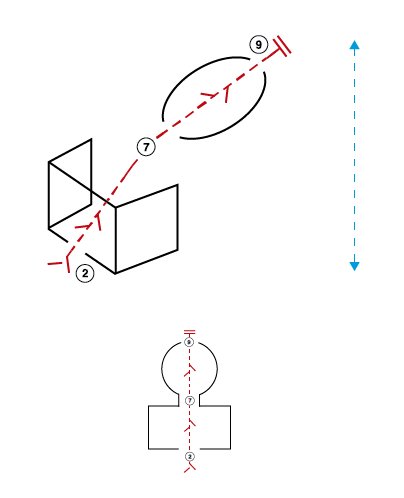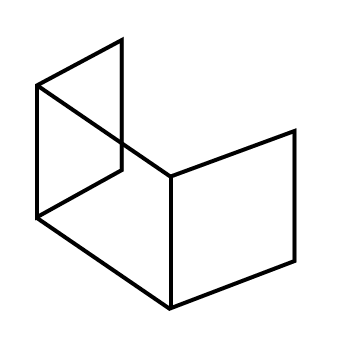_The Beam across Ki-Bu Temple,
open instrumentation (2022)




![]()
![]()
“Influenced by some of architecture's own systems of representation, this
series emphasizes the spatial rather than the temporal-linear experience of the
musical phenomenon. Plan and axonometry thus replace the linear arrangement
from left to right: the narrative dimension of this music is permeable to the
mystery of that which is circumstantial.
Thus, this image is the "architectural survey" of a temple that
does not exist, made up of 18 pavilions: 9 cubes and 9 spheres. It describes
form and structure, potentially: the passage from a main axis through the
square and angular to the circular and rounded, or vice versa.
The ensemble has this image as its only guide, being for each improviser
the limit to develop his own program within it.
Composed by a serie of 3 triptychs, this work can be performed in its
totality (9 figures), choosing only one triptych (3 figures) or choosing only
one figure.
In case of being performed in its totality (9 figures), the order of the
figures is subject to the agreement of the group. In the same way, the duration
is subject to the agreement of the group, taking into consideration that a
temple needs a certain temporality to be a temple.
It is not necessary overpopulate the space with sounds, as this serie
invites you to experience the amplitude of the place.”


“Influenced by some of architecture's own systems of representation, this
series emphasizes the spatial rather than the temporal-linear experience of the
musical phenomenon. Plan and axonometry thus replace the linear arrangement
from left to right: the narrative dimension of this music is permeable to the
mystery of that which is circumstantial.
Thus, this image is the "architectural survey" of a temple that does not exist, made up of 18 pavilions: 9 cubes and 9 spheres. It describes form and structure, potentially: the passage from a main axis through the square and angular to the circular and rounded, or vice versa.
The ensemble has this image as its only guide, being for each improviser the limit to develop his own program within it.
Composed by a serie of 3 triptychs, this work can be performed in its totality (9 figures), choosing only one triptych (3 figures) or choosing only one figure.
In case of being performed in its totality (9 figures), the order of the figures is subject to the agreement of the group. In the same way, the duration is subject to the agreement of the group, taking into consideration that a temple needs a certain temporality to be a temple.
It is not necessary overpopulate the space with sounds, as this serie invites you to experience the amplitude of the place.”
Thus, this image is the "architectural survey" of a temple that does not exist, made up of 18 pavilions: 9 cubes and 9 spheres. It describes form and structure, potentially: the passage from a main axis through the square and angular to the circular and rounded, or vice versa.
The ensemble has this image as its only guide, being for each improviser the limit to develop his own program within it.
Composed by a serie of 3 triptychs, this work can be performed in its totality (9 figures), choosing only one triptych (3 figures) or choosing only one figure.
In case of being performed in its totality (9 figures), the order of the figures is subject to the agreement of the group. In the same way, the duration is subject to the agreement of the group, taking into consideration that a temple needs a certain temporality to be a temple.
It is not necessary overpopulate the space with sounds, as this serie invites you to experience the amplitude of the place.”